ikfoundation.org
The IK Foundation
Promoting Natural & Cultural History
Since 1988


FASHION & REMODELLING OF CLOTHING
– A reverse Chronology from 1914 to 1810
The aim of this essay is to give a brief text summary and a few images of female fashions, together with some thoughts about women’s possibilities or wishes to stay fashionable and to keep, mend or remodel clothing throughout their lives. Fashion in chronological order is seen as the most natural way to study fashion history when, for example, looking at 19th-century garments. Another perspective arises when looking backwards in time, which must have been the normal view for generations of that era – one could only compare with the past or maybe have some slight knowledge of next season's new details for various garments.
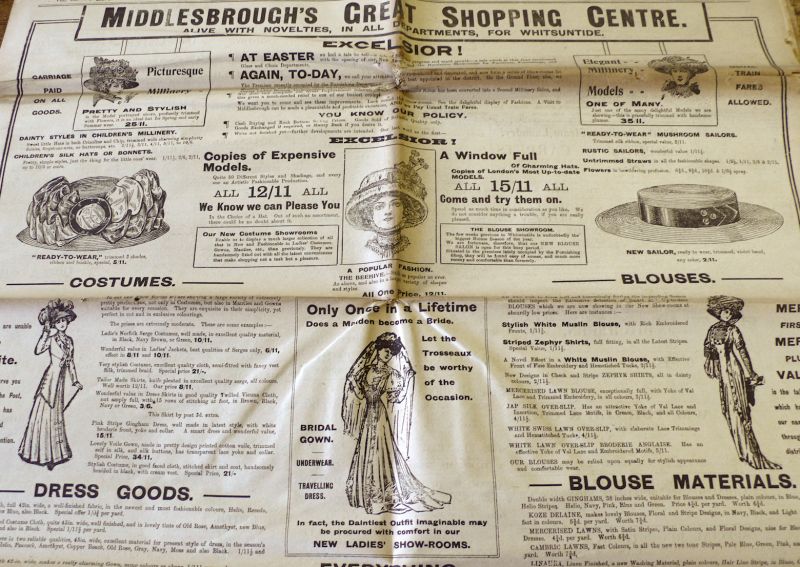 As in many magazines and newspapers of the early 20th century, the weekly Whitby Gazette included a regular column on Fashion in the period 1900-1914 at the same time as the advertisement for fashion and clothing in the paper increased in size. Department stores in nearby Middlesborough were for example frequently announcing their up-to-date fashions – often aiming at families with modest incomes – with slogans such as ‘Copies of Expensive Models’ (Collection: Whitby Gazette, May 14th, 1909, Whitby Museum, Library). Photo: Viveka Hansen.
As in many magazines and newspapers of the early 20th century, the weekly Whitby Gazette included a regular column on Fashion in the period 1900-1914 at the same time as the advertisement for fashion and clothing in the paper increased in size. Department stores in nearby Middlesborough were for example frequently announcing their up-to-date fashions – often aiming at families with modest incomes – with slogans such as ‘Copies of Expensive Models’ (Collection: Whitby Gazette, May 14th, 1909, Whitby Museum, Library). Photo: Viveka Hansen.Looking back on previous fashions, it could include what fashions they used in their youth, clothing inherited from their mother's youth, possible studies of old ladies/fashion magazines, comparisons with old portraits if they belonged to wealthy families, etc. How did all this form their up-to-date fashion of their present time? How interested were the 19th century everyday women in fashions of the past? This essay does not aim to answer all these questions but to give a few examples of these circumstances by looking backwards in time from 1914 to approximately 1810.
A Fashion study from 1914 to 1885
- 1907-1914. A dark skirt with a sash at the waist and a white blouse with embroidery, pleats and lace are now increasingly popular, a fashion clearly seen in many photographs from the Edwardian era. Skirts no longer trail on the ground, allowing the shoes to be seen, an altogether more comfortable style. Corsets also go out of fashion at the end of this period.
- 1900-1907. Tightly-laced hour-glass waist still demanded by fashion. Lightweight and light-coloured material becoming popular, often adorned with extensive machine-made lace. With the new century, the skirt begins to drag slightly to the back. A somewhat forward-leaning look helped by tightly-laced corsets is favoured, a fashion persisting with small changes up to 1907. After this date, corsets become longer and straighter in form. Large hats add to the effect. Long cream-coloured gloves or mittens matching the lightweight and light-coloured clothes were also extremely popular in the Edwardian era.
- 1898-1900. Development of white shirt and high collar. Stiffness disappears from the skirt in favour of a more fluid bell-like model with a matching jacket which could be worn open at the front. Hats are now larger than in the 1880s and often decorated with a large feather.
- 1893-1897. The waist is still tightly laced, with the bodice pointed at the back. Ample puff sleeves are a new fashion at this time, preferably in contrasting material so as to attract the maximum attention. Skirt falling free in a new flat line is an innovation during this decade.
- 1892-1893. Bustles and crinolines were no longer used; the skirt was simpler and free-hanging – over a starched petticoat – often decorated with velvet ribbons. Heavily boned bodice, high collar, often with an ornamental brooch and a shoulder section that may be decorated with lace, fringes, etc.
- 1885-1890. The bustle shrinks, dropping out of use about 1890; the material used becomes simpler, and the train disappears. A trend towards somewhat more comfortable clothes.
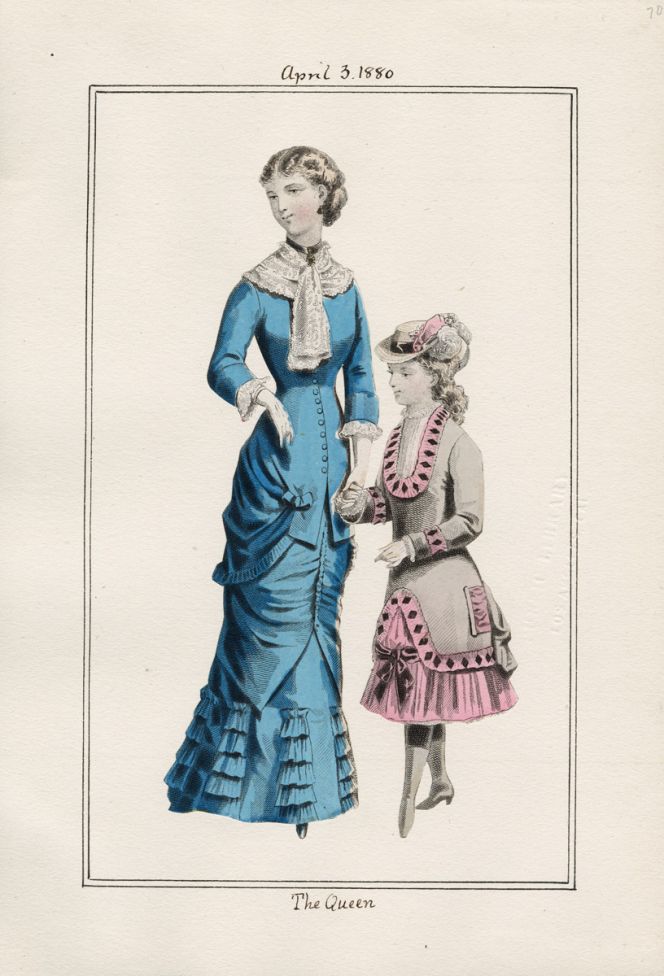 In the period from 1880 to 1885: The bustle now reaches its greatest size at the back, while the bodice is fastened with many buttons at the front and as before hangs down over the bustle, but the train begins to shrink from the middle of the decade. Pleating, gathering and decoration of the skirt reach a high point early in the decade but then diminish; sleeves are narrow. Silk and velvet favoured, preferably in combination. Clothes still extremely inconvenient to wear. However, some caution must be taken into account when studying fashion plates of this era, whilst idealised depictions were common. (Courtesy of: “The Queen”, A French Magazine, Casey Fashion Plates, Los Angeles Public Library, online collection).
In the period from 1880 to 1885: The bustle now reaches its greatest size at the back, while the bodice is fastened with many buttons at the front and as before hangs down over the bustle, but the train begins to shrink from the middle of the decade. Pleating, gathering and decoration of the skirt reach a high point early in the decade but then diminish; sleeves are narrow. Silk and velvet favoured, preferably in combination. Clothes still extremely inconvenient to wear. However, some caution must be taken into account when studying fashion plates of this era, whilst idealised depictions were common. (Courtesy of: “The Queen”, A French Magazine, Casey Fashion Plates, Los Angeles Public Library, online collection).From time to time during the whole of the 19th century, the favoured style happily looked back to bygone times – a so-called revival – which was combined with new needlework techniques and constantly changing fashion trends to create a complex interplay between new and old in female dress. However, it was not only historical inspiration that affected clothes but also influences from the stricter forms of men’s clothing, from both exotic imported goods and impressions of nature. In other words, these fluctuating crazes were derived from an enthusiasm for either nature, historical clothes and objects, or geographically distant places. These ideas also mixed with new expectations created by industrialisation to make a powerful impact on women’s clothes.
A Fashion study from 1880 to 1871
- 1875-1880. Bustles are still in fashion, with the train even longer and richly decorated with ribbons, fringes, etc. Velvet and silk are often added. The upper part is now like a jacket lying half over the bustle at the back. Small and ornately decorated hats were typical of this period, a style continuing into the 1880s. The bodice is built up in an increasingly complicated manner with many metal supports to ensure a perfect fit for the upper part of the body
- 1871-1875. Bustle now used to extend the dress behind as far as possible, leaving it flat in front but trailing somewhat at the back; usually, a three-piece dress extensively decorated with frills, lace, ribbons, flowers, etc. Clothes are highly impractical and uncomfortable for both walking and sitting.
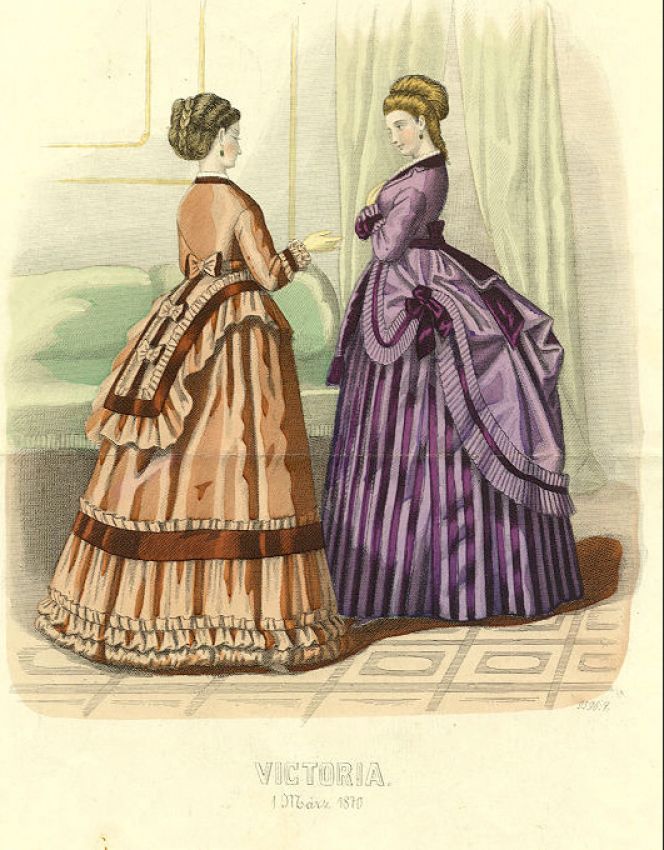 In the period from 1867 to 1870: Skirt now flatter in front but still prominent behind, preferably made of plain material decorated with every type of fringe and ribbon or other applied ornaments. The collar usually high, sleeves again narrow and straight. Decoration was now what mattered most, the garment itself being simpler than before. (Courtesy of: Fashion Magazine, “Victoria”, 1870, Wikipedia).
In the period from 1867 to 1870: Skirt now flatter in front but still prominent behind, preferably made of plain material decorated with every type of fringe and ribbon or other applied ornaments. The collar usually high, sleeves again narrow and straight. Decoration was now what mattered most, the garment itself being simpler than before. (Courtesy of: Fashion Magazine, “Victoria”, 1870, Wikipedia).A Fashion study from 1864 to 1837
- 1862-1864. Skirts now reach their greatest extent, to resemble a balloon usually draped with a black or white machine-made lace shawl. Skirt trailing to some extent at the back. The parasol, which needed to match the rest of the outfit, now became an ever more vital accessory.
- 1850s. Sleeves getting wider to reach their greatest extent about 1857-58, skirt very wide and held by a gathering; heavy brocade-woven silk, preferably decorated with fringes and ribbons; dresses often three-piece with a fringed triangular shawl. A growing trend away from the horsehair crinolines that increased the breadth of the skirt, in favour of the new crinoline frames that considerably increased the skirt’s extent all round
- 1840-1843. Heavier dress material, often fine brocade-woven silk or wool. Even more marked, pointed waist tightly drawn together with a more tightly sitting bodice than before; narrow arms often with pleats, and very wide skirt but tight gathering at the waist. The skirt is sometimes now adorned with fringes and ribbons, and with an overall increase of decoration. The cap is now quite small and worn on the back of the head. It is fastened with ribbon with the brow and front hair left bare.
- 1837-1840. Day dress, usually in silk or fine wool with a printed flowered pattern. Sleeves are now generally narrower, with width only remaining in the middle with the upper sleeve, wrist gathered in, pointed waist (a novelty) and great width in the skirt, which is gathered together tightly. Often, a small cape is placed over the shoulders in matching material. The bonnet now reaches its greatest size, frequently decorated with silk, velvet ribbons and feathers.
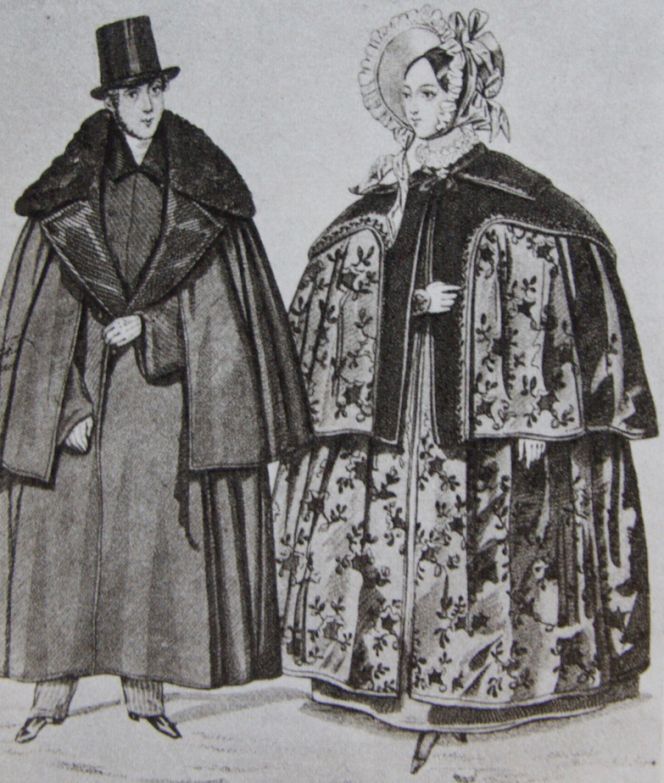 The necessity or tradition of changing or re-using older clothes to fit new purposes was widely spread. Due to that reality, few major outer garments of the older type have been preserved, since the fabric was ideal for recycling to make children’s clothes and the like once the original was out of fashion. This fashion plate from 1834 shows very clearly the large quantity of cloth needed to make a full-length cape. (Fashion Magazine “Theaterzeitung”, 1834).
The necessity or tradition of changing or re-using older clothes to fit new purposes was widely spread. Due to that reality, few major outer garments of the older type have been preserved, since the fabric was ideal for recycling to make children’s clothes and the like once the original was out of fashion. This fashion plate from 1834 shows very clearly the large quantity of cloth needed to make a full-length cape. (Fashion Magazine “Theaterzeitung”, 1834).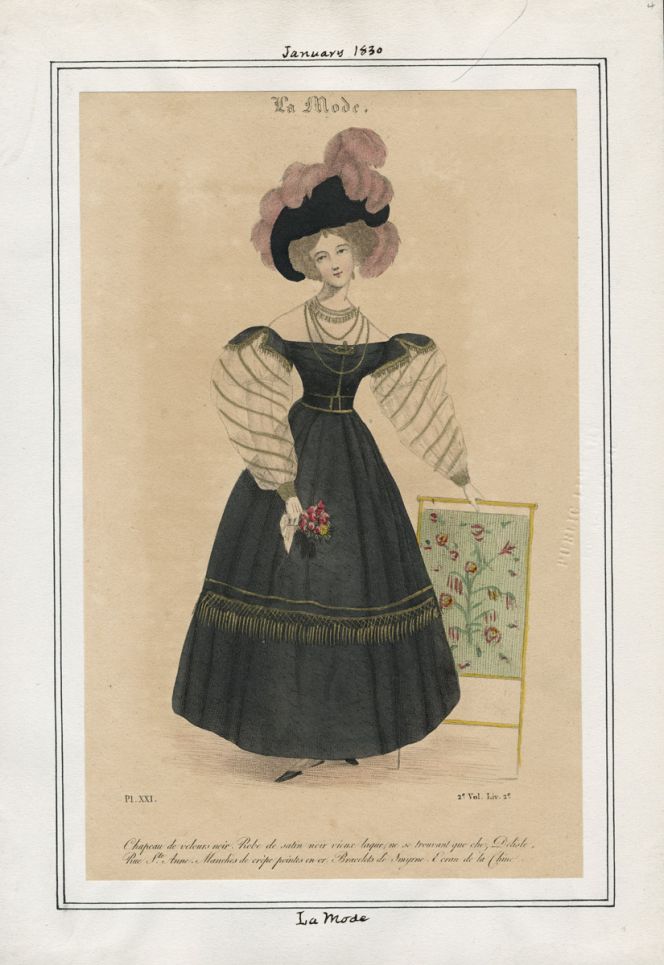 In the period from 1830 to 1833. Muslin day dress, often in printed cloth with stylised motifs of flowers, leaves or other vegetation, very wide sleeves and increased width in the skirt, drawn together in a tight gathering at the waist. Only the lower part of the sleeve at the wrist is narrow and close-fitting. Great width in the dress, though this is usually made of light, thin material. The waist of the dress has moved down a little further still, so that it is now at the level of the natural waist. (Courtesy of: “La Mode” 1830, Casey Fashion Plates, Los Angeles Public Library, online collection).
In the period from 1830 to 1833. Muslin day dress, often in printed cloth with stylised motifs of flowers, leaves or other vegetation, very wide sleeves and increased width in the skirt, drawn together in a tight gathering at the waist. Only the lower part of the sleeve at the wrist is narrow and close-fitting. Great width in the dress, though this is usually made of light, thin material. The waist of the dress has moved down a little further still, so that it is now at the level of the natural waist. (Courtesy of: “La Mode” 1830, Casey Fashion Plates, Los Angeles Public Library, online collection).A Fashion study from 1828 to 1830
- Cotton day dress, upper sleeves more voluminous (and now at their puffiest) with the puff stretching halfway down the sleeve and ending in a cuff; the waist lower and often marked by a belt or sash; the skirt wider, often richly embroidered and sometimes decorated with a variety of ribbons. Even if the passion for white cotton material declined, it had not yet ended.
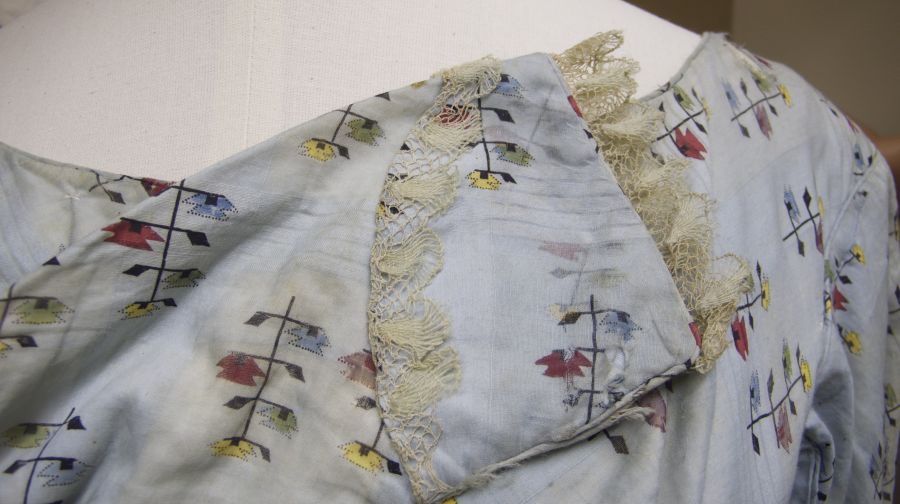 Close up study of a dress, circa 1820. Printed cotton and handmade bobbin laces. In the period from 1810 to 1825: Cotton day dress with waist high under the breast – the waist line began to drop at the end of this period – long narrow sleeves with puffed or narrow shoulders in printed cotton with a small motifs, flounce on the edge of the skirt; a straight style with many similarities to the previous fifteen years. White muslin cap preferably with bobbin lace and openwork embroidery, tied under the chin. (Dress: Whitby Museum, Costume Collection, unnumbered at time of research). Photo: Viveka Hansen.
Close up study of a dress, circa 1820. Printed cotton and handmade bobbin laces. In the period from 1810 to 1825: Cotton day dress with waist high under the breast – the waist line began to drop at the end of this period – long narrow sleeves with puffed or narrow shoulders in printed cotton with a small motifs, flounce on the edge of the skirt; a straight style with many similarities to the previous fifteen years. White muslin cap preferably with bobbin lace and openwork embroidery, tied under the chin. (Dress: Whitby Museum, Costume Collection, unnumbered at time of research). Photo: Viveka Hansen.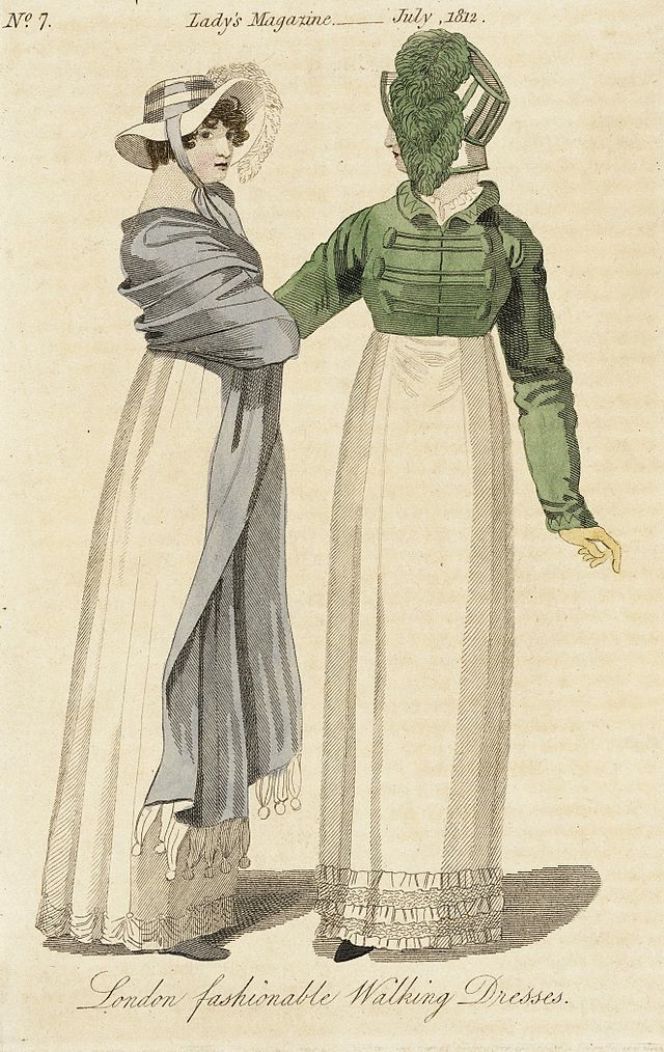 Two ladies in “London fashionable Walking Dresses”– Lady’s Magazine in July, 1812. (Wikipedia: Public Domain).
Two ladies in “London fashionable Walking Dresses”– Lady’s Magazine in July, 1812. (Wikipedia: Public Domain).Various research demonstrates that women traditionally “collected” many garments in their youth – either purchased, sewn by a professional dressmaker or tailor, stitched by herself or by a female relative. For most individuals, one must emphasise that these clothes were often altered and re-used in all possible ways. The ordinary woman’s wardrobe must, at regular intervals, obviously have seen new additions throughout her life, whilst some clothes lasted for a lifetime or were even inherited by her daughters. How often a woman altered her fashion was, of course, highly individual, probably more often the younger and more affluent she was, and many times middle-aged and elderly women “stayed in the same fashion style” as in their younger years.
Sources:
- Ashelford, Jane, The Art of Dress – Clothes and Society 1500-1914, London 2002.
- Art Galleries Committee of the Corporation of Manchester, Women’s Costume 1800-1835, 1835-1870, 1870-1900 & 1900-1930 (four books), Manchester 1952.
- Hansen, Viveka, The Textile History of Whitby 1700-1914 – A Lively Coastal Town Between the North Sea and North York Moors, London & Whitby 2015.
- Whitby Gazette, 1900-1914 (Whitby Museum, Library & Archive).
- Whitby Museum, Costume Collection (Based on personal research in 2007-2010 of a wide range of 19th century clothing).
Essays
The iTEXTILIS is a division of The IK Workshop Society – a global and unique forum for all those interested in Natural & Cultural History from a textile Perspective.
Open Access essays, licensed under Creative Commons and freely accessible, by Textile historian Viveka Hansen, aim to integrate her current research, printed monographs, and earlier projects dating back to the late 1980s. Some essays feature rare archive material originally published in other languages, now available in English for the first time, revealing aspects of history that were previously little known outside northern European countries. Her work also explores various topics, including the textile trade, material culture, cloth manufacturing, fashion, natural dyeing, and the intriguing world of early travelling naturalists – such as the "Linnaean network" – viewed through a global historical lens.
For regular updates and to fully utilise iTEXTILIS' features, we recommend subscribing to our newsletter, iMESSENGER.
been copied to your clipboard




– a truly European organisation since 1988
Legal issues | Forget me | and much more...
You are welcome to use the information and knowledge from
The IK Workshop Society, as long as you follow a few simple rules.
LEARN MORE & I AGREE







